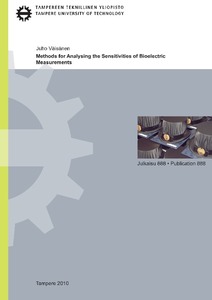Methods for analysing the sensitivities of bioelectric measurements
Väisänen, Juho (2010)
Väisänen, Juho
Tampere University of Technology
2010
Luonnontieteiden ja ympäristötekniikan tiedekunta - Faculty of Science and Environmental Engineering
This publication is copyrighted. You may download, display and print it for Your own personal use. Commercial use is prohibited.
Julkaisun pysyvä osoite on
https://urn.fi/URN:NBN:fi:tty-201005251135
https://urn.fi/URN:NBN:fi:tty-201005251135
Tiivistelmä
In the 21st century the trend in healthcare is towards the early detection and prevention of disease and from hospitalization to increased personalization. The novel wearable and implantable systems for electrocardiographic (ECG) and electroencephalographic (EEG) measurements are being developed to enable monitoring of people during their everyday lives or in emergency situations.
The objectives of these novel devices and bioelectrical measurements in general are to register signals arising from a certain region of interest (ROI). The aim might be to direct the measurement to a limited area of the cardiac muscle, such as an apical region of ventricles. This is of particular interest when monitoring different cardiac arrhythmias or changes in activation of a certain segment of the myocardium after infarction. The sensitivity of an ideal measurement should give greater and more intense focus on these target areas than on other areas of the volume conductor, thus yielding more specific and better quality measurements. When designing novel measurement devices and setups it would be beneficial to know where to locate the electrodes in order to measure the target signals and monitor their source regions as efficiently as possible. This is especially important in the application of wearable or implantable measurement systems when there is a limit to the number and location of recording electrodes.
The selection of the electrode system should be based on quantitative analysis of certain characteristics such as sensitivity distributions. Because different electrode setups are suitable for different measurement purposes or conditions it would be beneficial to be able to evaluate their sensitivity properties before conducting the actual measurements. The modelling of bioelectric measurements provides an effective means of studying sensitivity distributions.
The present thesis introduces a novel quantitative analysis method called region of interest sensitivity ratio (ROISR) for the evaluation of bioelectric measurement setups through the modelling of sensitivity distributions. ROISR is applied to analyse the specificity of EEG and ECG measurement setups to a certain ROI within brain and heart. Using simulations and measurements, the thesis proposes that the ROISR method developed here has a strong correlation to the signal-to-noise ratio (SNR) of a measurement and thus provides an efficient tool for the analysis and development of bioelectric measurement setups.
In the thesis the sensitivity distribution analysis is also applied to the analysis of the effects of the dimensions of an implantable ECG device on measurement. The interelectrode distance was found to be the major factor in implant design that determines sensitivity. Other parameters related to implant dimensions have only a minor effect on the average sensitivity of the measurement. It was also observed here that implanting the electrodes deeper under the skin has major effects on the local sensitivities in heart muscle which may affect the morphology of the measured ECG.
The objectives of these novel devices and bioelectrical measurements in general are to register signals arising from a certain region of interest (ROI). The aim might be to direct the measurement to a limited area of the cardiac muscle, such as an apical region of ventricles. This is of particular interest when monitoring different cardiac arrhythmias or changes in activation of a certain segment of the myocardium after infarction. The sensitivity of an ideal measurement should give greater and more intense focus on these target areas than on other areas of the volume conductor, thus yielding more specific and better quality measurements. When designing novel measurement devices and setups it would be beneficial to know where to locate the electrodes in order to measure the target signals and monitor their source regions as efficiently as possible. This is especially important in the application of wearable or implantable measurement systems when there is a limit to the number and location of recording electrodes.
The selection of the electrode system should be based on quantitative analysis of certain characteristics such as sensitivity distributions. Because different electrode setups are suitable for different measurement purposes or conditions it would be beneficial to be able to evaluate their sensitivity properties before conducting the actual measurements. The modelling of bioelectric measurements provides an effective means of studying sensitivity distributions.
The present thesis introduces a novel quantitative analysis method called region of interest sensitivity ratio (ROISR) for the evaluation of bioelectric measurement setups through the modelling of sensitivity distributions. ROISR is applied to analyse the specificity of EEG and ECG measurement setups to a certain ROI within brain and heart. Using simulations and measurements, the thesis proposes that the ROISR method developed here has a strong correlation to the signal-to-noise ratio (SNR) of a measurement and thus provides an efficient tool for the analysis and development of bioelectric measurement setups.
In the thesis the sensitivity distribution analysis is also applied to the analysis of the effects of the dimensions of an implantable ECG device on measurement. The interelectrode distance was found to be the major factor in implant design that determines sensitivity. Other parameters related to implant dimensions have only a minor effect on the average sensitivity of the measurement. It was also observed here that implanting the electrodes deeper under the skin has major effects on the local sensitivities in heart muscle which may affect the morphology of the measured ECG.
Kokoelmat
- Väitöskirjat [4773]
